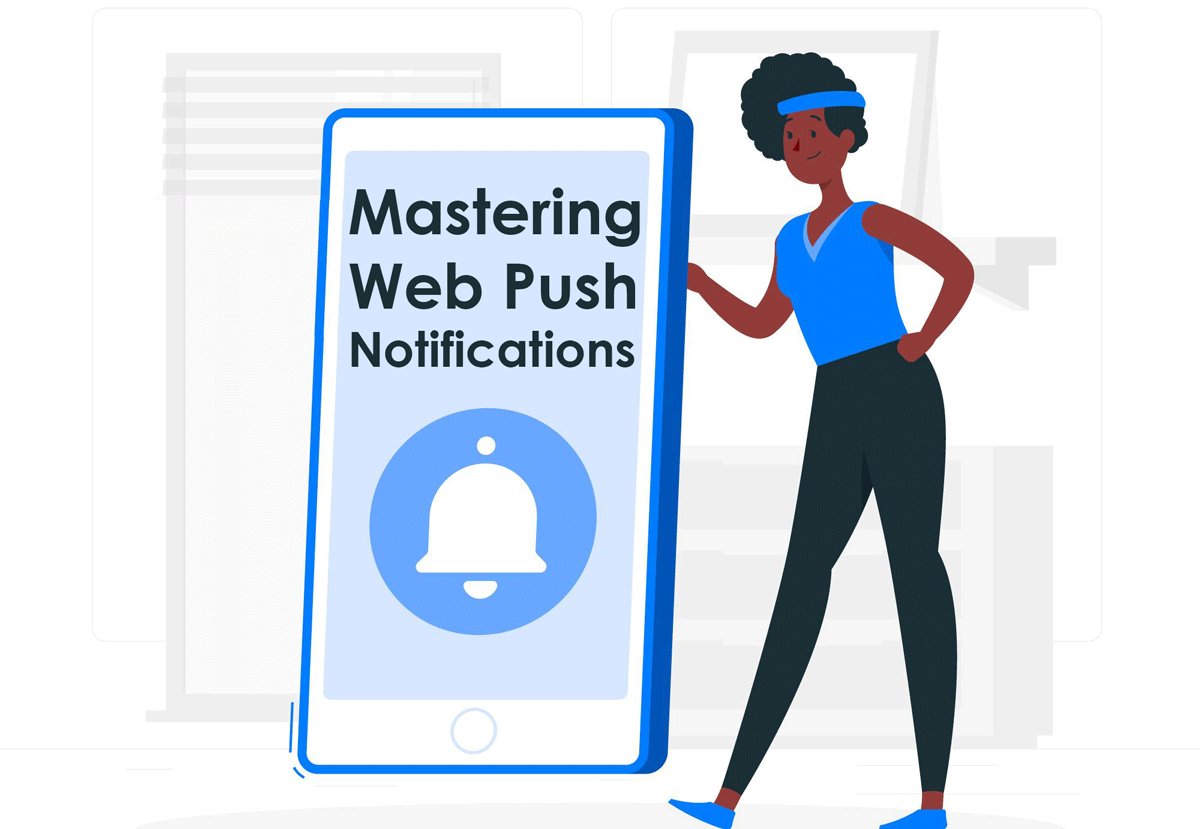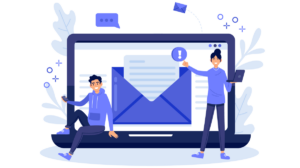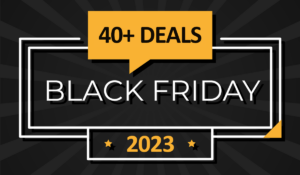
Mastering Web Push Notifications – Comprehensive Guide
Web push notifications have emerged as a powerful tool for businesses to engage with their audience in real-time, directly on their browsers. However, to leverage this tool effectively, it’s crucial to understand and implement best practices that maximize engagement while respecting user preferences. In this comprehensive guide, we’ll delve into the intricacies of web push notifications and provide detailed insights into each best practice.
Opt-in Process
The opt-in process for web push notifications is a crucial step in engaging users effectively while respecting their privacy preferences. Typically, when a user visits a website for the first time, they may encounter a prompt requesting permission to send push notifications. This prompt should provide clear information about the purpose of the notifications and how they will benefit the user experience, such as receiving updates, alerts, or personalized content.
Users are given the choice to either allow or deny these notifications. Opting in implies the user grants permission for the website to send push notifications to their device, while opting out indicates they prefer not to receive such notifications. It’s essential for websites to prioritize transparency and provide an easy way for users to manage their notification preferences, including the ability to opt out at any time.
Respecting users’ choices and privacy preferences is key to maintaining trust and fostering positive user experiences.
- Seamless Integration: Integrate the opt-in process seamlessly into the user experience, ensuring it doesn’t disrupt their browsing flow. For example, instead of interrupting users with a pop-up immediately upon landing on the website, consider waiting for a natural break in their browsing session.
- Transparency: Clearly communicate the benefits of subscribing to notifications, outlining what users can expect to receive. Provide examples of the type of notifications they’ll receive, such as exclusive offers, product updates, or relevant content.
- Timing: Avoid prompting users for opt-in at inconvenient times or too frequently. For instance, wait until they’ve spent some time on the site and engaged with the content before presenting the opt-in prompt.
- Customization: Personalize opt-in prompts to align with your brand’s voice and design aesthetics, enhancing the overall user experience. Consider using branded visuals and language that resonates with your target audience.
Personalization
Personalizing web push notifications with unique text is a powerful strategy to enhance user engagement and relevance. By tailoring messages to individual preferences, behaviors, or demographics, websites can deliver more compelling and meaningful content to their audience.
For example, leveraging user data such as browsing history, past interactions, or preferences, websites can craft personalized messages that resonate with each recipient. Whether it’s recommending products based on previous purchases, providing exclusive offers tailored to specific interests, or delivering relevant updates based on user activity, personalized text adds a personal touch that captures attention and drives action.
By incorporating dynamic variables such as first name, location, or recent actions into notification text, websites can further enhance the personalization experience, making users feel valued and understood. However, it’s essential to balance personalization with respect for user privacy and preferences, ensuring that recipients have control over the information they receive and how it’s used.
- Segmentation: Divide your audience into segments based on demographics, behavior, and preferences to deliver highly targeted notifications. For example, an e-commerce retailer may segment users based on their purchase history, browsing behavior, or geographic location.
- Dynamic Content: Utilize dynamic content to customize notifications for specific user segments, increasing relevance and engagement. For instance, personalize recommendations based on past purchases or offer location-specific promotions.
- Data Utilization: Incorporate user data such as browsing history, purchase behavior, and preferences to tailor notifications to individual interests, further enhancing personalization. For example, a travel website could send notifications about deals to destinations the user has previously shown interest in.
Timing and Frequency
Timing and frequency play critical roles in the effectiveness of web push notifications. The timing of a notification can significantly impact user engagement, as sending messages at the right moment increases the likelihood of them being noticed and acted upon. For instance, delivering notifications during peak user activity periods or when users are most likely to be receptive can maximize their impact.
Additionally, the frequency of notifications is essential for maintaining a positive user experience. Bombarding users with excessive notifications can lead to annoyance, fatigue, and ultimately, opt-outs. Conversely, infrequent notifications may cause users to disengage or forget about the website altogether. Striking the right balance between frequency and relevance is crucial for keeping users engaged without overwhelming them.
- Optimal Timing: Send notifications at times when users are most likely to be engaged, considering factors such as time zone and historical interaction patterns. For instance, schedule notifications for weekdays during peak browsing hours.
- Frequency Management: Strike a balance between staying top-of-mind and avoiding notification fatigue by limiting the frequency of messages. Consider segmenting users based on their engagement levels and adjusting the frequency accordingly.
- Smart Scheduling: Implement smart scheduling algorithms that consider user activity and behavior patterns to deliver notifications at the most opportune moments. For example, send reminders for abandoned carts shortly after the user has left the website.
Clear and Compelling Messaging
- Conciseness: Keep notification messages concise and to the point, ensuring users can grasp the message at a glance. Avoid overwhelming users with too much information.
- Actionable Language: Use actionable language that prompts users to take specific actions, such as making a purchase, signing up for a webinar, or exploring new content. For example, use phrases like “Shop Now,” “Learn More,” or “Unlock Your Offer.”
- Visual Appeal: Experiment with different messaging formats, including emojis, gifs, and rich media, to capture users’ attention and make notifications visually appealing. For instance, include product images or animations to showcase new arrivals or promotions.
Value Proposition
The value proposition is crucial in the effectiveness of web push notifications as it directly influences user engagement and response rates. A compelling value proposition clearly communicates the benefit or value that users will gain by interacting with the notification. Whether it’s exclusive offers, relevant updates, personalized recommendations, or timely information, the value proposition motivates users to take action.
Without a clear value proposition, users may ignore or dismiss notifications, leading to missed opportunities for engagement and conversions. By highlighting the unique benefits and relevance of the notification content, websites can capture users’ attention and drive desired actions effectively.
Moreover, aligning the value proposition with users’ interests, preferences, and needs enhances the overall user experience and fosters a sense of trust and loyalty. When users perceive value in the notifications they receive, they are more likely to continue engaging with the website and remain receptive to future communications.
- Providing Value: Offer tangible value with every notification, whether it’s exclusive deals, personalized recommendations, or relevant updates tailored to user preferences. For example, offer a discount code for loyal customers or provide early access to a new product line.
- Benefit-focused Messaging: Focus on communicating the benefits to the user rather than solely promoting products or services, enhancing the perceived value of notifications. Highlight how the notification will enhance their experience or solve a problem they’re facing.
- Continuous Refinement: Continuously evaluate and refine your value proposition based on user feedback, performance metrics, and market trends to ensure ongoing relevance and effectiveness. Solicit feedback from users through surveys or polls to understand their preferences and adjust your messaging accordingly.
A/B Testing
A/B testing web push notifications involves creating multiple variations of a notification to assess which version performs better in terms of user engagement and conversion rates. For example, marketers might test different message texts, call-to-action buttons, or delivery times to determine the most effective approach. By randomly assigning users to receive different variations and analyzing key metrics like open rates and click-through rates, marketers can gain valuable insights into user preferences and optimize their notification strategies for maximum impact and effectiveness.
- Experimentation: Conduct A/B tests to compare different elements of your notifications, including messaging, timing, visuals, and calls to action. Test variations of your notifications to identify what resonates best with your audience.
- Data-Driven Optimization: Analyze the results of A/B tests to identify which variations drive the highest engagement and conversion rates. Use this data to optimize your notification strategy and refine your approach over time.
- Iterative Improvement: Iterate on your notification strategy based on insights gained from A/B testing, continuously refining and optimizing performance over time. Implement iterative improvements based on data-driven insights to maximize the effectiveness of your notifications.
Opt-Out Mechanism
The opt-out process of web push notifications is crucial for ensuring a positive user experience and respecting users’ preferences for communication. Typically, users should have the option to easily unsubscribe or opt out of receiving push notifications from a website if they no longer wish to receive them. This process should be straightforward, transparent, and readily accessible to users.
From a user experience perspective, the opt-out process should be hassle-free and intuitive. Websites should provide clear instructions on how to opt out, whether through a settings menu, a dedicated unsubscribe link within the notification itself, or another easily accessible method. Additionally, users should not face any barriers or hurdles when opting out, such as having to log in or provide additional information.
The importance of the opt-out process lies in maintaining user trust and respecting their preferences. By giving users control over their notification settings and honoring their decision to opt out, websites demonstrate a commitment to user privacy and a positive user experience. Failing to provide a straightforward opt-out process can lead to user frustration, decreased engagement, and even damage to the website’s reputation.
- Respectful Opt-Out: Provide users with an easy and visible opt-out mechanism, respecting their preferences and ensuring a positive user experience. Include an unsubscribe link or button in every notification to give users the option to opt-out.
- Clear Communication: Clearly communicate how users can unsubscribe from notifications, whether through browser settings or within your website, to empower them with control over their notification preferences. Provide clear instructions on how users can manage their notification settings.
- Monitoring and Adjustments: Monitor opt-out rates and gather feedback to identify potential issues or areas for improvement, making adjustments to your notification strategy as needed to minimize opt-outs and maximize engagement. Analyze opt-out data to understand trends and patterns, then make informed decisions to address any issues.
Compliance and Privacy
Compliance and privacy are paramount considerations when implementing web push notifications. Websites must adhere to various privacy regulations, such as GDPR (General Data Protection Regulation), CCPA (California Consumer Privacy Act), and others, to ensure the protection of user data and privacy rights.
- Regulatory Compliance: Adhere to relevant regulations such as GDPR and CCPA when collecting and processing user data for push notifications, ensuring compliance with privacy laws and protecting user rights. Implement measures to safeguard user data and ensure compliance with applicable regulations.
- Explicit Consent: Obtain explicit consent from users before sending them notifications, providing clear information about data usage and giving users the option to opt-in or opt-out based on their preferences. Obtain consent through a clear and prominent opt-in process that explains the purpose and benefits of receiving notifications.
- Transparency and Accountability: Be transparent about your data practices, privacy policies, and notification policies, fostering trust and accountability with your audience. Provide clear and accessible information about how user data is collected, used, and protected, and be responsive to user inquiries and concerns about privacy and data security.
Cross-Channel Integration
Cross-channel integration with web push notifications involves synchronizing push notification campaigns with other marketing channels, such as email, SMS, social media, and more, to create a cohesive and coordinated user experience across multiple touchpoints. By leveraging data and insights from various channels, marketers can deliver more personalized and targeted messaging to users, increasing engagement and driving conversions. For example, a user who abandons their shopping cart on a website might receive a web push notification reminding them to complete their purchase, followed by a follow-up email with a special discount offer. This integrated approach ensures consistent messaging and maximizes the chances of re-engaging users effectively. Moreover, cross-channel integration allows marketers to track and analyze user interactions across different channels, providing valuable insights into user behavior and preferences to inform future marketing strategies.
- Holistic Approach: Integrate web push notifications with other marketing channels, such as email, SMS, and social media, to create a cohesive and integrated communication strategy. Coordinate messaging and timing across channels to ensure a consistent brand experience and maximize reach and engagement with your audience.
- Consistency and Coordination: Coordinate messaging and timing across channels to ensure a consistent brand experience and maximize reach and engagement with your audience. Align messaging and branding elements across channels to create a seamless user experience and reinforce brand identity.
- Data Synergy: Leverage user data from different channels to create a unified view of user preferences and behaviors, enabling more targeted and personalized communication strategies across all touchpoints. Use data integration and analytics tools to aggregate and analyze data from multiple channels, gaining insights into user behavior and preferences to inform your notification strategy.
Performance Monitoring and Optimization
Performance monitoring and optimization are essential components of managing successful web push notification campaigns. Marketers closely monitor key metrics such as open rates, click-through rates (CTR), conversion rates, unsubscribe rates, and delivery rates to assess the effectiveness of their notifications. By analyzing these metrics, marketers gain valuable insights into user behavior, preferences, and campaign performance. They can identify which notifications resonate most with their audience, understand factors that contribute to engagement or disengagement, and make informed decisions to optimize future campaigns. Optimization strategies may include A/B testing different message variations, refining targeting criteria, adjusting timing and frequency, or updating the content to better align with user interests. Continuous monitoring and optimization ensure that web push notifications remain relevant, engaging, and effective in driving desired user actions while enhancing the overall user experience.
- Key Metrics: Track key performance metrics such as click-through rates, conversion rates, opt-out rates, and engagement metrics to evaluate the effectiveness of your notification campaigns. Use these metrics to assess the impact of your notifications and identify areas for improvement.
- Analytics Insights: Utilize analytics tools to gain deeper insights into user behavior, preferences, and trends, enabling data-driven decision-making and optimization of your notification strategy. Analyze user engagement patterns, segment performance, and campaign effectiveness to identify opportunities for optimization.
- Continuous Improvement: Continuously monitor and optimize your web push notification campaigns based on performance data, user feedback, and market dynamics, striving for ongoing improvement and innovation in your engagement efforts. Implement iterative improvements based on data-driven insights to maximize the effectiveness of your notifications and drive meaningful results.
Conclusion
Mastering web push notifications requires a strategic approach that balances user engagement, personalization, compliance, and performance optimization. By implementing the best practices outlined in this guide and incorporating detailed examples, businesses can effectively leverage web push notifications to engage with their audience, drive action, and achieve their marketing objectives. Whether it’s optimizing the opt-in process, personalizing messaging, or monitoring performance metrics, a comprehensive and informed approach is essential for success in the dynamic landscape of digital marketing.


